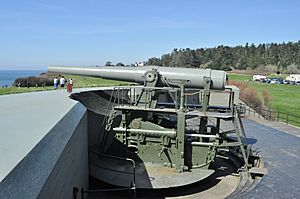Fort Standish (Boston, Massachusetts) facts for kids
Quick facts for kids Fort Standish |
|
|---|---|
| Part of Harbor Defenses of Boston | |
| Lovell's Island, Massachusetts | |

10-inch disappearing gun at Fort Casey, Washington state, similar to those at Fort Standish.
|
|
|
Location in Massachusetts
|
|
| Coordinates | 42°19′45.67″N 70°55′40.29″W / 42.3293528°N 70.9278583°W |
| Type | Coastal Defense |
| Site information | |
| Owner | Massachusetts |
| Controlled by | Massachusetts Department of Conservation and Recreation |
| Open to the public |
yes |
| Site history | |
| Built | 1899 |
| Built by | United States Army |
| In use | 1904-1946 |
| Battles/wars | World War I World War II |
Fort Standish was a military fort built on Lovell's Island in Massachusetts. It was finished in 1907. The fort was named after Myles Standish, an important figure in early American history.
This fort was a key part of the defenses for Boston Harbor. It worked with other forts like Fort Warren and Fort Andrews to protect the city. Fort Standish had many large guns, called artillery batteries. It was used until 1947, when it was closed down. Later, in 1962, it became part of the Boston Harbor Islands National Recreation Area.
Contents
Fort Standish: A Look at Its History
Building the Fort and Its Big Guns
Fort Standish was built between 1899 and 1907. Its main job was to protect Boston from enemy ships. The fort had several types of powerful guns.
- Big Guns: Batteries Burbeck and Morris had 10-inch guns. These were the fort's strongest weapons. They were designed to stop large enemy battleships. These guns used a special "disappearing" carriage. This meant the gun would pop up to fire, then drop back down behind a wall for protection.
- Medium Guns: Batteries Terrill and Whipple had 6-inch guns. These could fire faster than the 10-inch guns. They were good for fighting smaller, quicker enemy ships like cruisers.
- Smaller Guns: Batteries Vincent, Weir, and Williams had 3-inch guns. These were "rapid fire" guns. Their job was to protect underwater minefields. They would stop enemy ships trying to clear the mines.
The fort was first used by soldiers in 1909. At that time, some of the biggest guns were still being set up.
Fort Standish During the World Wars
World War I Changes
When the United States joined World War I in 1917, Fort Standish became even more important. New buildings were added to house more soldiers and supplies. Some of the fort's 10-inch guns were considered for use as special "railway guns." These guns could be moved on train tracks. However, they stayed at the fort.
Two 6-inch guns were also removed for a short time. They were meant to be used on field carriages, but they returned to the fort later. The fort also got two anti-aircraft guns to shoot down enemy planes.
World War II and Beyond
Before the United States entered World War II in 1941, Fort Standish grew again. More temporary buildings were added. The number of soldiers at the fort increased to about 800 men.
In 1942, the fort's largest 10-inch guns were removed and scrapped. Newer, more powerful forts like Fort Duvall had taken over their role. The 6-inch guns of Battery Terrill were also removed in 1943. This left only a few batteries active.
Later, new 90 mm guns were added to help protect against enemy Motor Torpedo Boats. These were smaller, faster boats.
The Fort's Final Years
After World War II ended, Fort Standish was no longer needed. Its remaining guns were removed in 1946 and 1947. The fort was then closed down.
In 1958, the island where the fort stood was given to the state of Massachusetts. A few years later, in 1962, it became part of the Boston Harbor Islands National Recreation Area. Today, visitors can explore the remains of Fort Standish and learn about its history.



